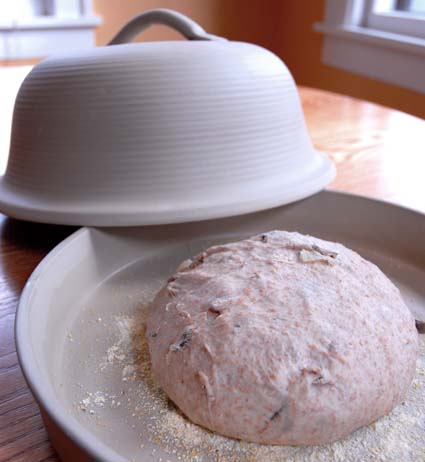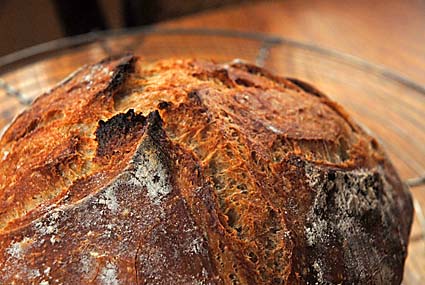Incredible crust: bread-baking in a cloche

Many readers have asked about baking bread inside a closed cast-iron pan, based on a much older method, where bread is baked inside a closed clay pot (or “cloche,” meaning bell, in French). Both methods depend on trapped steam from the dough to create a perfect crust, but the clay pot has the added benefit of being porous, so moisture is trapped, but also conducted away from the surface as the bread bakes. I tested the Sassafras brand “La Cloche” product, and I’m very impressed with the crust I’m getting –take a look at the picture above; this crust is thin and shatters when broken (the burned bits are perfect in artisan loaves; that’s how you know you’ve baked long enough). Keep in mind that these crust results are hard to re-create with loaves very high in whole wheat (because of oils in the wheat’s germ). The bread above is about 15% whole grains– it’s a light version of the Peasant Loaf in the book, and of course the basic recipe works great in this situation. Whole grain breads perform beautifully in “La Cloche,” but the crust tends to be softer and thicker. One other thing to note–any clay product is somewhat fragile, and after some years of owning the Sassafras product, the base did crack (still quite usable with a stone underneath).
For crust aficionados, I think the “La Cloche” results are a little better than what I get inside closed cast-iron.
Sassafras claims that James Beard once said that this method gave him bread that was “nothing short of phenomenal.” “Beard on Bread” was the first bread cookbook I ever used–my wife brought it to our marriage, and then taught me to use it (click here and scroll down to meet Laura).
If James liked a product, I have to give it a try. Before using “La Cloche,” rinse it in hot water to get rid of any ceramic powder left over from manufacturing, and let it dry overnight. The first time you use it, apply a light coating of vegetable oil to the inside of the bottom piece (the bell-shaped top part doesn’t need it). The ceramic is very fine-grained and won’t absorb a lot of oil so it didn’t smoke when I pre-heated this thing to 450 F. You don’t need to cure the oil coating before you bake your first loaf. You’re ready to bake.
There are two ways to use La Cloche: the way that Sassafras officially endorses (putting a cool cloche into a preheated oven bearing raw dough that has rested/risen on cornmeal inside), or what I’ve found works better: preheating the top and bottom pieces of La Cloche to full baking temperature for 30 minutes, and then transferring fully-rested loaves into it (carefully!). The crust result is fantastic; you can rest/rise in a banneton, then drop the dough into the hot bottom tray of the cloche, then cover (click here for my post on how to use a banneton). Baking time is the usual as written in our recipes. The other easy method is to rest/rise the loaf on parchment paper and just drop the loaf, with the paper, into the hot cloche. Cover and bake.
You don’t need a baking stone, you don’t need to introduce water into the oven for steam, and you don’t need to dampen the cloche; all the moisture you need comes from the dough and is trapped inside. One important point: Open the lid for the last third of baking, or the bread will not brown.
This is a very romantic baking dish (is that possible?); using it makes you think you’re in a different century. It’s heavy, and very tactile– here it is with an unbaked boule sitting in it (cool-cloche method):

Here’s the banneton-risen bread after the lid was removed to finish baking open to oven air:

There are two problems with the Sassafras-approved cool-cloche method: first, baking time is longer than written in our recipes, because the clay vessel has a lot of heat to absorb before the interior is up to baking temperature. Second, the crust just isn’t a crisp. So, even though the Sassafras instructions say to use a cool cloche, I’m going with a hot one. Keep in mind that this product doesn’t appear to be warranted against cracking, whether you follow their instructions or not. One important care instruction: never use soap on pottery baking vessels, just hot water and a clean scrub brush.
Years ago, Daniel Wing and Alan Scott wrote “The Bread Builders,” which was mainly about building your own wood-fired masonry and brick bread oven in your backyard (I’ll definitely do that someday). But they also had lots to say about the “La Cloche” product, which they thought was almost as good as their wood-fired masonry ovens. They interviewed the product’s inventor at Sassafras who told them that the fully-preheated method for using this product “…is fine.”
Good enough for me. Look at this bread!
Note: BreadIn5.com is reader supported–when you buy through links on the site, BreadIn5 LLC earns commissions.

We’ve been baking in a cloche using coals from a wood fire as part of a historical cooking demo for almost twenty years now… It makes *incredible* bread. Because they’re cheap, we’ve been using bowl shaped terra-cotta planters for our cloche. We cracked more than a few while working out the techniques. We’ve cracked fewer in the years since, but we’ve learned that cracking is inevitable when heating pottery.
Hence many of our folks also use a terra-cotta pot at home. They’re getting hard to find of late… almost everything is plastic now a days.
Interesting. I assume it’s food-grade.
Nope, bog standard straight from the home center. But it never touches the dough, so it’s not a big deal. At the demo, the dough is straight on to firebrick. At home, we use a terra cotta plate for the bottom with a bit of parchment paper.
Jeff, In comparing artisan loaves in a cloche heated to 450 degrees versus a covered pot heated to 500 degrees, do you notice any difference in the oven spring?
Ricki: Both of these resulted in great oven-spring, not sure we noticed a difference. In theory, the higher temp might produce more. My concern about doing that with the ceramic cloche is that its very high thermal mass, greater even than most cast-iron pans, will retain the very high heat even after turning the oven down at the 15-minute mark. That might result in an over-baked loaf. All depends on your equipment and your oven, could test both ways…
Thanks Jeff. I have never preheated the Cloche, so I’ll give that a go first. Thanks for the suggestion.
Ricki
I have a Römertopf that we occasionally use for oven cooking juicy dishes. Would that work as a cloche? I hesitate to put it into the oven empty to preheat, that it would crack. Also, we always soak it before using, then put it into a cold oven. Has anyone experimented with one?
Hi. Yes, I have one and have used it for baking bread. Having said that, there is no guarantee that it won’t crack and I would hate for that to happen to a piece you are so attached to. Just for an abundance of caution, I would recommend using a Dutch oven or Cloche that we’ve used and recommended for baking the bread.
Thanks, Zoë
I have been baking bread, at least once a week, in Romertopf and Schlemmertopf terracotta casseroles for several years now. My pots range from completely unglazed, to the inside of the base only glazed, to my treasured Schlemmertop which has a completely decorative glaze all over on the outside. I only soak the inside of the top cover while the finally shaped bread rises in the bottom of the pot which I simply line with a good parchment paper. I then place all into the cold oven and set the thermostat to 200°C. After thirty to 50 minutes, I have a beautifully raised and browned loaf with a lovely crust and a soft tender crumb. I never even need to remove the top for final browning. I have never had a pot crack or break. Just dont ever put it down on a cold or wet surface when you bring it out of the oven. Place it on a cork mat or a towel or a silicone place mat. It is a sudden difference in temperature (known as thermal shock) which causes breakage.
If I want to place another pot in the oven when the first one comes out, then I place my next cold pot with the risen dough, into my microwave convection oven and bring it up to about 160°C using a Convection only, ( literally only takes about 10+ minutes ) and then transfer it into my very hot conventional oven. Works a treat.
Terrific Harry, thanks for sharing that. Sorry your comment took so long to go live.
I have used this cloche for over 10 years without issues. If you soak the lid with some water you get a softer crust. Without soaking it’s crunchy to hard. Both are good. I found that a comment in the NYT No Knead Bread article to be very effective. Don’t preheat the oven first. Instead use the energy to do part of the proofing in the covered cloche. I bake this way at 475F for 30 minutes, in a convection oven (timer doesn’t begin until baking temperature is reached). Then I take the cover off for about 10 minutes. When bread temperature is 200-210F (a few degrees above 210 is ok), the bread is done. I usually check when crust has darken.
Hi Zoe,
I ran into your realm via my Great Course on Baking Bread. Got your book on Artisan in 5 minutes and will be trying your method soon. Looked up your Best of on Amazon and note first 17 pages of sample are identical with my Artisan copy. Good stuff anyhow, and note your course offering is also identical with lectures you do on Great Courses. Sounds like I already have the meat of your excellent “mix once and bake for two weeks”, so I can get on with doing much better bread here in Mid-coast Maine. Solid month of sub-freezing temps, so the oven will help out.
Even at 90, it’s great to find something new to replace the old methods I’ve used to bake for years using French and Italian methods. Don’t have the time, patience or energy for that stuff any more, so your new ideas are welcome to go along with our lobsters.
Cheers,
Bill
Hi Bill,
I am thrilled you will be giving our method a try. The book you got should be a great companion to the class and we are here if you have any questions.
Enjoy the bread and stay warm! Zoë
Thanks, the makers don’t have a copy of their instructions available on their site!
Hi John: Which instructions are you asking about? I have many instructions here on the site.
Hi there, i bought a cloche. My bead always sticks to the top, how do I prevent this happening ?
It seems like you just have to make a smaller loaf. What size loaf for you making?